El equipo de producto de Microsoft nos revela las primeras fases de información de la nueva versión. Conócela.
Ve los videos aquí.
El equipo de producto de Microsoft nos revela las primeras fases de información de la nueva versión. Conócela.
Ve los videos aquí.
stsadm can inadvertently delete a root site collection if erroneous URL path used
ERROR:
No content databases are available for this operation. Create a content database , and then try the operation again. To create a content database, click "Content databases" on the Application Management page, select the Web application to use, and then click "Add a content database".
Going to the now dead root site you get:
404 FILE NOT FOUND
http://support.microsoft.com/default.aspx/kb/968474
Microsoft Office SharePoint Server 2007 unsupported scenarios using stsadm -o export /import of subsites
Microsoft Office SharePoint Server 2007 does not support stsadm -o import of subsites based on the publishing feature as a root site collection as this subsite would have orphaned information stored in the root site the subsite was exported from.
Mensaje de error cuando intenta tener acceso a un servidor local mediante su nombre COMPLETO o su alias CNAME después de instalar Windows Server 2003 Service Pack 1: "acceso denegado " o " ningún proveedor de red acepta la ruta de acceso de red determinado"
http://support.microsoft.com/kb/926642/es
Error message when you try to access a server locally by using its FQDN or its CNAME alias after you install Windows Server 2003 Service Pack 1: "Access denied" or "No network provider accepted the given network path"
La herramienta de Microsoft por excelencia para el manejo y administración de proyectos a nivel corporativo es Project Server, actualmente versión 2007. Este se integra con SharePoint para ofrecer interesantes beneficios para el almacenamiento de documentos relacionados a proyectos, tareas o entregables (deliveries), y de igual forma para apoyar un poco con la parte de colaboración –permisos, flujos, etc-
Bueno, pues se ha liberado un nuevo Kit de apoyo a la medición de Performance para implementaciones de Project Server 2007, un whitepaper o documento y también un lab.
The white paper answers the following often asked questions:
This white paper contains a description of an actual performance tuning lab for Microsoft Office Project Server 2007.
The first chapter (“Running a Project Server 2007 Performance Test Lab”), describes how to run performance tests against a Office Project Server 2007 deployment by using Visual Studio Team System 2008 and a set of community-based tools built for the purpose.
The second chapter (“Test Environment”), documents the specifics of the lab environment that was used for the tests we ran for collecting data for this white paper.
The third chapter (“Test Results”), describes in detail the test scenarios that were conducted, and it summarizes the data collected for every scenario.
The Project Server 2007 Performance Lab Kit contains two Visual Studio solutions/tools to help you test your farm environment for capacity planning purposes: the “EPMTestTools” and the “EPM Stress Test” solution.
Para más información consultar el Blog de Christophe Fiessinger
Muy recomendable!!
Cuando usar una Web Application independiente: (Que es una Web Application, o Aplicación Web desde el punto de vista de SharePoint, para qué me sirve o cuando necesito una?)
Generally speaking, use dedicated Web applications to:
Separate content available to anonymous users from content available to authenticated users.
Isolate users. For example, you can ensure that partners do not have access to intranet content by placing partner sites in a separate Web application.
Enforce permissions. A dedicated Web application provides the opportunity to enforce permissions by policies by using the Policy for Web Application page in Central Administration. For example, you can create a policy to explicitly deny write access to one or more groups of users. Policies for a Web application are enforced regardless of permissions configured on individual sites or documents within the Web application.
Optimize database performance. Applications achieve better performance if they are placed in Web applications with other applications of similar data characteristics. For example, the data characteristics of My Sites typically include a large number of sites that are small in size. In contrast, team sites typically encompass a smaller number of very large sites. By placing these two different types of sites in separate Web applications, the resulting databases are composed of data with similar characteristics, which optimizes database performance.
Optimize manageability. Because creating separate Web applications results in separate sites and databases, you can implement different limits for each site’s Recycle Bin, expiration, and size, and negotiate different service-level agreements. For example, you might allow more time to restore sites that are not critical to your business.
Respecto al uso de site Collections: (Que es un Site Collection o Colección de Sitios, desde el punto de vista de SharePoint, para qué me sirve o cuando necesito una?)
A site collection is a set of Web sites that have the same owner and share administration settings. Each site collection contains a top-level Web site and can contain one or more subsites.
The recommended guideline for acceptable performance is to implement fewer than 50,000 site collections per Web application. Scaling out by distributing site collections across multiple database servers provides additional storage capacity and throughput.
Site collections introduce several sharing and isolation opportunities that affect permissions, navigation, and feature deployment.
The following items can be shared within a site collection and cannot be shared across site collections:
Master pages
Page layouts
Images
Site templates
Additionally, permissions and navigation are isolated at the site collection level in the following ways:
Subsites within a site collection can inherit permissions from the top-level site.
Site collections cannot inherit permissions from other site collections.
There is no built-in navigation from one site collection to another.
Finally, Office SharePoint Server 2007 aggregates search results across site collections based on a user’s permissions, regardless of the number of site collections or databases (depending on search scopes).
Finalmente, sobre sites: (Que es un Site o sitio, desde el punto de vista de SharePoint, para que me sirve o cuando necesito uno?)
A site is one or more related Web pages that are hosted inside a site collection.
The guideline for acceptable performance is to implement fewer than 250,000 sites per site collection. You can create a very large total number of Web sites by nesting the subsites. For example, 100 sites, each with 1000 subsites, is 100,000 Web sites. The maximum recommended number of sites and subsites is 125 sites with 2,000 subsites each, for a total of 250,000 sites.
Sites include built-in navigation from one subsite to another within a site collection. There is no built-in navigation from one site collection to another.
As with site collections, separate sites are vulnerable to cross-site scripting attacks from other sites within the domain.
From within each site, you can add user or group accounts to the Owners group for that site.
Ahora, dentro de los sitios almacenamos información y/o documentos. (finalmente, como manejamos y utilizamos la información que almacenamos o subimos a un sitio de SharePoint –que finalmente se almacena en la base de datos previamente definida de SQL Server-).
SharePoint sites are flexible and can help you accomplish many different things. However, to have a useful and successful site or group of sites, you need to be able to focus the sites on some primary objectives. That is, you need to know what you are trying to accomplish with a site before you can design it. For example:
Do you want to communicate with others in your organization by posting bulletins or announcements and gathering feedback?
Do you want to foster team collaboration by giving team members a place to share ideas and work on projects together?
SharePoint sites can assist with both of these objectives. If you have multiple objectives, you might best be served by creating multiple, possibly interrelated, sites. However, you can have multiple objectives for a single site. If you are limited to a single site, organize the site so that users looking for the communication point can find it right away, and users looking to share information and ideas or store documents know where to start.
Review the following objectives. Consider which of these objectives most closely align with your needs for each site you are designing.
Document storage and workflow are key functions of many sites, even sites that are primarily used for communication or collaboration. However, sometimes you might need a dedicated document storage site for your organization. Whether you require a special site for document storage depends on many factors, such as how many documents need to be stored, how many people are contributing documents, who needs to act on the documents, and so on. You will have time to explore how to structure document storage later in the planning process. For more information, see Plan document libraries (Windows SharePoint Services).
Document storage sites or document storage sections of other sites often include the following features:
The ability to check documents in or out, track changes to documents, and keep multiple versions of documents.
The ability to route documents for approval or through specific processes before publishing them to a larger audience.
.gif) Note:
Note:
Windows SharePoint Services 3.0 includes a workflow capability that you can use to create a custom workflow process to route documents for approval.
The ability to tag documents with metadata, so that documents can be more efficiently sorted and managed.
Para más info: Plan document libraries y Plan site and features
Dentro de las capacidades que ofrece Microsoft Office SharePoint Server (MOSS) 2007, hay algo llamado Content Deployment o publicación de contenido. Si recuerdan dentro de aquel diagrama ya conocido de funcionalidades del producto –una como esfera de colores-, tenemos algo que es la Administración de Contenido, lo cuál provee una serie de habilidades para administrar la información que se genera o crea, edita, revisa, autoriza y finalmente se publica.
Piensen en el siguiente escenario: cuando las empresas generan contenido mediante alguna aplicación interna (podría ser, haciendo uso de algún sitio o aplicación web dentro de la Intranet), para que posteriormente se revise, autorice y publique dicha información al sitio público a cierta sección o página web disponible para los usuarios en Internet. Hay empresas que tenían o tienen el producto de Microsoft para crear portales públicos y publicar información, Microsoft Content Management Server (MCMS) 2002 o cualquier otro producto.
En la versión de SharePoint 2007, hubo una integración de las versiones anteriores (2003): SharePoint 2003 –producto para crear Intranets Corporativas- y por otro lado MCMS 2002 –producto para crear Portales Públicos, como por ejemplo: www.empresa.com– como ya comentamos anteriormente;e ahora fueron mejorados e integrados en un solo producto: SharePoint 2007.
Entonces, la funcionalidad de manejar todo el ciclo de vida de la información documental desde la creación (inicio) hasta la publicación del contenido (final), ha sido incorporada a SharePoint 2007 (partiendo de la funcionalidad básica que ofrecía MCMS 2002), y todas las características que están incluidas en un set de capacidades orientadas a esto se llama Web Content Management (WCM)
Existe la información necesaria para saber como funciona y configurar la parte de Replicación de contenido (Content Deployment) una vez aceptada o autorizada donde se creó para posteriormente su publicación en automático hacia dicho portal o sitio con permisos para el público anónimo en cuestión., sin la necesidad de copiar manualmente o hacer el backup y restore de el ambiente de creación al de publicación final. Es muy recomendable también descargar el último SDK de MOSS 2007 para mayor información.
A continuación, del blog de Stefan Gossner, tenemos una serie de mejores práticas sobre Content Deployment que vale la pena tener en cuenta para cuando vayamos a configurar esta funcionalidad en nuestra implementación de MOSS 2007.
En unos días será liberado oficialmente el CU de Abril, el cual se recomienda instalar después de haber aplicado el Service Pack 2 tanto para WSS 3.0 como para MOSS 2007
WSS the uber package
http://support.microsoft.com/hotfix/KBHotfix.aspx?kbnum=968850&kbln=en-us
MOSS the current available packages
http://support.microsoft.com/hotfix/KBHotfix.aspx?kbnum=968859&kbln=en-us
Para más información:
http://blogs.msdn.com/joerg_sinemus/archive/2009/05/01/should-i-install-sp2-and-or-april-cu.aspx
Bueno, pues finalmente se llevó a cabo el Segundo Seminario Latinoamericano de SharePoint, ahora en México, el primero se llevó a cabo en Costa Rica.
Después de un par de meses de arduo trabajo, logística, preparación, coordinación de las platicas y temas con los speakers y ver los detalles, estabamos casi listos.
En esta ocasión también contamos con expositores internacionales como por ejemplo Hector Insua, MVP SharePoint Bolivia y Joel Olson, toda una personalidad en el mundo de SharePoint.
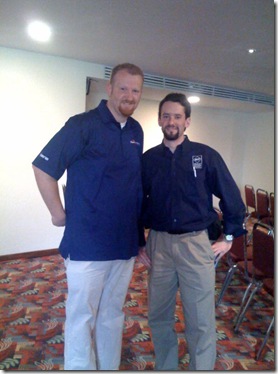 Aqui tomandonos una foto antes de que empiece el evento, Joel Olson y un servidor Luis Du Solier |
Compartiendo algunos post de algunos expositores sobre el evento:
Vladimir Medina
Impresiones de Hector Insua en Mexico
Impresiones de Joel Oleson en Mexico
Hector Insua
2do Simposio – Volviendo de México!
Joel Olson
Seminario Latinoamericano de SharePoint
Where’s Waldo I mean Joel- This week is Virginia & DC
Tuvimos aproximadamente 250 registrados y como 200 presenciales!
Para ver mas fotos del evento: https://cid-48d54a134a0e8e5a.skydrive.live.com/browse.aspx/SharePoint/FotosSimposio
Para descargar las presentaciones: http://cid-48d54a134a0e8e5a.skydrive.live.com/browse.aspx/PresentacionesSimposio
Contamos con la asistencia de gente de la Comunidad de Project y esperamos hacer cosas interesantes en un futuro, así como la de SQL Server.
Platiquemos un podo el detalle del evento, como fue…
Llegamos a montar todo aproximadamente a las 6:45 am al hotel antes de que empezara la gente a llegar., y comenzamos.
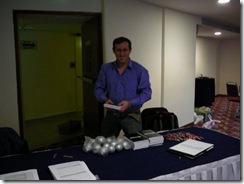 |
 |
 |
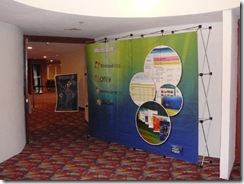 |
El registro empezó temprano a las 8:00 am, la gente comenzó a llegar al Hotel Fiesta Americana en Reforma #80 (anuncio en la parte inferior derecha de la vitrina).
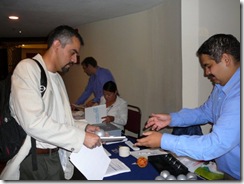 Vladimir apoyando en el registro |
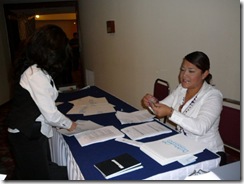 Yola apoyando en el registro y recibiendo gente |
 Hector ayudando en el registro |
 Todos apoyando desde temprano. |
Empezó el evento a las 9:00 am, y fue muy grato ver como casi estaba lleno desde el inicio, en el registro les repartimos la agenda del día, una encuesta, publicidad de softwareguru así como de centros de entrenamiento de Microsoft, plumas, y libretas donadas por Microsoft para anotaciones.
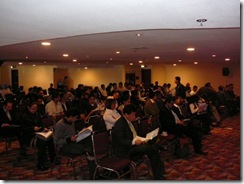 |
 |
Comenzamos, dando la bienvenida al evento platicando que fue organizado por la Comunidad de SharePoint México, también contamos con la participación de los patrocinadores que nos apoyaron con reconocimientos como Microsoft por ejemplo y varios que ya indicamos al inicio del artículo.
Iniciamos entonces con la primera plática introductoria:
Introducción a SharePoint 2007 [Expositores: Luis Du Solier y Haaron González]
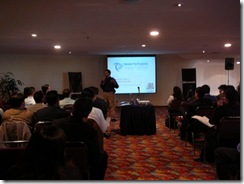 Luis Du Solier dando la Introducción a SharePoint 2007 |
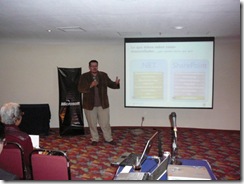 Haaron González dando una introducción al desarrollo sobre SharePoint 2007 |
Continuamos con la segunda plática:
Desarrollo de WebParts en SharePoint 2007 [Expositor Misael Monterroca]
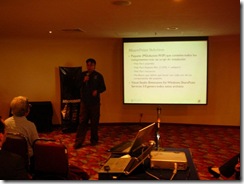 Misael dando la sesión de desarrollo en SharePoint 2007 |
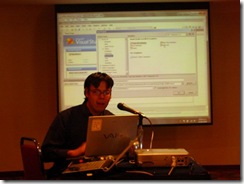 Misa haciendo su tremendo demo |
La tercer plática del día:
Experiencia de usuario en sitios de SharePoint 2007 [Expositores: Rodrigo Díaz, y Mauricio Angulo]
Y para cerrar las pláticas de la mañana que tenían un enfoque más orientado a desarrolladores o developers,
Aplicaciones de negocio basadas en Office 2007 (OBA) y SharePoint 2007 [Expositor: Haaron González]
Terminamos las pláticas de la mañana y continuamos con los temas de los It Pros y Gerentes de TI
Comenzando con la primer plática de la tarde:
Windows Server 2008 y SQL Server 2008 con SharePoint 2007. [Expositores: Hector Insua, Rubén Colomo, el equipo de SQL PASS y Vladimir Medina].
Después tuvimos la ponencia de Joel Olson
10 Steps to Successful SharePoint Deployment [Expositor: Joel Olson, invitado especial desde Estados Unidos]
Luego tuvimos también la participación de Tomas Hernández, experto en SQL y Reporting Services de Microsoft.
Manejo de reportes como apoyo a la toma de decisiones. [Expositor Tomás Hernández]
(a partir de este momento se me terminó el espacio para tomar fotos en mi cámara, en cuanto me pasen mas actualizo el artículo, una disculpa)
Para terminar cerramos con broche de oro, con el Product Marketing Manager de SharePoint de Microsoft México.
Impacto de SharePoint en la prodictividad empresarial. [Expositor: Francisco Hernández]
Queremos agradecer a nuestros principales patrocinadores:
 |
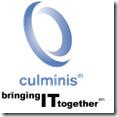 |
|
|
|
 |
Y a otros patrocinadores que también nos apoyaron.
 |
 |
|
 |
 |
Se ha liberado el Service Pack 2 para Windows SharePoint Services 3.0 y Microsoft Office SharePoint Server (MOSS) 2007
We are happy to announce that Service Pack 2 for Office SharePoint Server 2007 and Windows SharePoint Services 3.0 has been released to the Microsoft Download Center. It includes all the fixes prior to SP2, and also several enhancements to improve server farm performance, availability and stability. Plus, a new stsadm operation has been added to help customers prepare for the upgrade to the next version of SharePoint. We recommend installing this new service pack and to help, I’ve assembled links to the KB articles, downloads, install steps and benefits.
Download Links
Service Pack 2 for Windows SharePoint Services 3.0, x86 & x64
http://www.microsoft.com/downloads/details.aspx?FamilyId=79BADA82-C13F-44C1-BDC1-D0447337051B&displaylang=en
Service Pack 2 for Office SharePoint Server 2007, x86 & x64
http://www.microsoft.com/downloads/details.aspx?FamilyId=B7816D90-5FC6-4347-89B0-A80DEB27A082&displaylang=en
Slipstream Builds For Windows SharePoint Services 3.0
Windows SharePoint Services 3.0 with SP2, x64
http://www.microsoft.com/downloads/details.aspx?FamilyId=9FB41E51-CB03-4B47-B89A-396786492CBA&displaylang=en
Windows SharePoint Services 3.0 with SP2, x86
http://www.microsoft.com/downloads/details.aspx?FamilyId=EF93E453-75F1-45DF-8C6F-4565E8549C2A&displaylang=en
Benefits
Customers can be benefited from the following enhancements with Service Pack 2.
Service Pack 2 includes many fixes and enhancements designed to improve performance, availability, and stability in your server farms, including:
Service Pack 2 continues to improve SharePoint interoperability with other products and platforms.
A new preupgradecheck operation is added to stsadm tool. It can be used to scan your server farm to establish whether it is ready for upgrade to SharePoint Products and Technologies «14». It identifies issues that could present obstacles to the upgrade process. It checks for several SharePoint Products and Technologies «14» system requirements, including the presence of Microsoft® Windows Server® 2008 and a 64-bit hardware, and provides feedback and best practice recommendations for your current environment, together with information on how to resolve any issues that the tool discovers.
The full explanation of SP2 benefits can be downloaded here:
http://go.microsoft.com/fwlink/?LinkId=148551
Para más información consulta el Blog del Equipo de Producto de SharePoint en http://blogs.msdn.com/sharepoint
Celebremos y agradezcamos lo que la naturaleza nos provee.
Y de paso les comparto algunos links relacionados.
How to Reduce Energy Consumption, Waste, and Costs while Increasing Efficiency and ROI
Innovating to improve the Planet – un interesante sitio altamente recomendable que tiene mucho que ver con el ahorro de energía y utilización de los recursos.
Recordemos uno de los Top 10 points según Gartner más importantes del 2008, referente a las TI
Y claro, no podía faltar, Why SharePoint is Green?